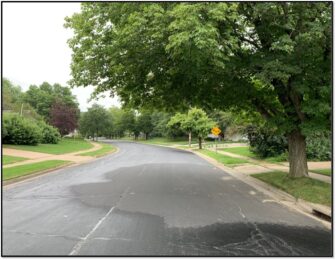
Research site for the United States Geological Survey in Fond Du Lac, Wisconsin, that shows the interception capabilities of a street tree canopy. Image: Bill Selbig
By Audrey Richardson
A recent study heightens the importance of trees for keeping cities from flooding.
Removing a single tree can increase stormwater runoff by 1,585 gallons, researchers reported in the Urban Forestry and Urban Greening journal in August. Understanding these numbers is important in the context of climate change and the increase of frequency and severity of storms, said James Kruegler, project manager for the New York Department of Environmental Conservation and a lead author of the study.
Stormwater management solutions are timely in Michigan as Detroit experienced its second 500-year flood event in seven years in June of last year. A 500-year flood event means there is a one in 500, or .2% chance of a flood of that measure occurring.
As the frequency of these storms increases, the aged public infrastructure becomes more prevalent, Richard Norton, professor of urban and regional environmental planning at the University of Michigan, told Midstory. Using trees to lessen the impact of these storms offer an easy solution.
The study’s findings are far greater than previous estimates on quantifying the benefits of urban street trees.
Modeling performed for the Environmental Protection Agency in 2018 estimated that one tree prevented 59 gallons in stormwater runoff, Krueger said. “It was the last universal standard value we had for how much avoided runoff did the average tree provide.”
The new estimate is over 25 times as much.
This time around the researchers used a computer software system to simulate changes in tree canopies and the addition of impervious surfaces like pavement on the water cycle. The United States Forest Service uses the system to evaluate and share the benefits of trees to communities across the country.
The system examines “when we have a tree, how much rainwater can that tree store and keep from hitting the ground and becoming runoff,” Kruegler said. The findings are based on data gathered in the field in Fond Du Lac, Wisconsin.
One organization that is using this research is the Urban and Community Forestry Program in Michigan. This program aims to expand urban tree cover and ensure that the trees that are being planted are right for the area. The program was created by Michigan’s Department of Natural Resources.

Volunteers with the Detroit Tree Equity partnership plant trees at a Greening of Detroit event in October. Image: Lawrence Sobson
The organization uses the software system regularly, said Kevin Says, Urban Community Forestry program manager.
“It has been fundamentally important in improving our understanding of urban forest structure, function and benefit analysis,” he said.
The added benefits of having community tree cover is what makes trees incredible, said Lawrence Sobson, Urban and Community Forestry program forester.
“These benefits go beyond decreasing stormwater runoff,” Sobson said. “There’s heat, air quality, community health and pavement life benefits. Having a canopy that can withstand these weather events is a relatively easy sell compared to a lot of other things in terms of climate change solutions.”
Engaging citizens in building urban forests will benefit communities in many aspects of life, Sayers said.
“Urban heat islands are real – trees can help,” Sayers said. “Urban stormwater flooding is real – trees can help. Social, mental, physical health issues are real – trees can help. Energy, air and carbon issues are real – trees can help.”
Results from the research papers help realize the extent of ecosystem services that trees provide, Kruegler said. This allows environment organizations to back up their advocacy with real numbers.
“We do hope that studies like this and our specific results can reach groups interested in protecting and expanding tree canopy in urban areas,” Kruegler said.